Deep within the African desert, a plant that defies time and astonishes researchers exists—a true enigma known as Welwitschia mirabilis. Fondly referred to as the “desert octopus,” this remarkable plant thrives exclusively in the Namib Desert, making it a true endemic marvel.
Welwitschia mirabilis defies estimation of its age, but it is known to live for centuries, making it a living relic. One of its most captivating features is its peculiar growth pattern—it possesses only two leaves that emerge from the seed and persist throughout its lifetime.
These leaf blades, resembling elongated ribbons, perpetually grow due to the presence of a basal meristem, a specialized plant tissue responsible for its continuous expansion.
With a sturdy and unchanging stem, the continuous growth of its two leaves results in lengths exceeding 2 meters over time, entangled and weathered by the harsh desert environment.
Welwitschia mirabilis has witnessed the passage of millions of years, yet today, it faces the threat of extinction due to its slow growth rate and challenges associated with cultivation outside its natural habitat.
Surprisingly, this desert-dwelling plant has adapted ingenious survival strategies. It absorbs precious water from the nightly dew through its leaves and possesses a complex metabolic system that enables efficient gas exchange. To prevent water loss, it keeps its stomata, the tiny leaf pores, closed during the day.
Remarkably, Welwitschia mirabilis stands alone in the botanical classification, with no close botanical relatives. As the sole representative of the Welwitschia genus, it belongs to the Gnetophyta division—an intriguing group of seed-producing plants.
While sharing certain traits with gymnosperms like pine trees, its vascular system resembles that of angiosperms such as magnolias, revealing a fascinating evolutionary connection.
Join us on a captivating journey into the world of Welwitschia mirabilis, as we unravel its mysteries and delve into the astonishing survival tactics of this enduring desert marvel.
| Taxonomic Rank | Classification |
|---|---|
| Kingdom | Plantae |
| Division | Gnetophyta |
| Class | Gnetopsida |
| Order | Welwitschiales |
| Family | Welwitschiaceae |
| Genus | Welwitschia |
| Species | mirabilis |
What is Welwitschia mirabilis?
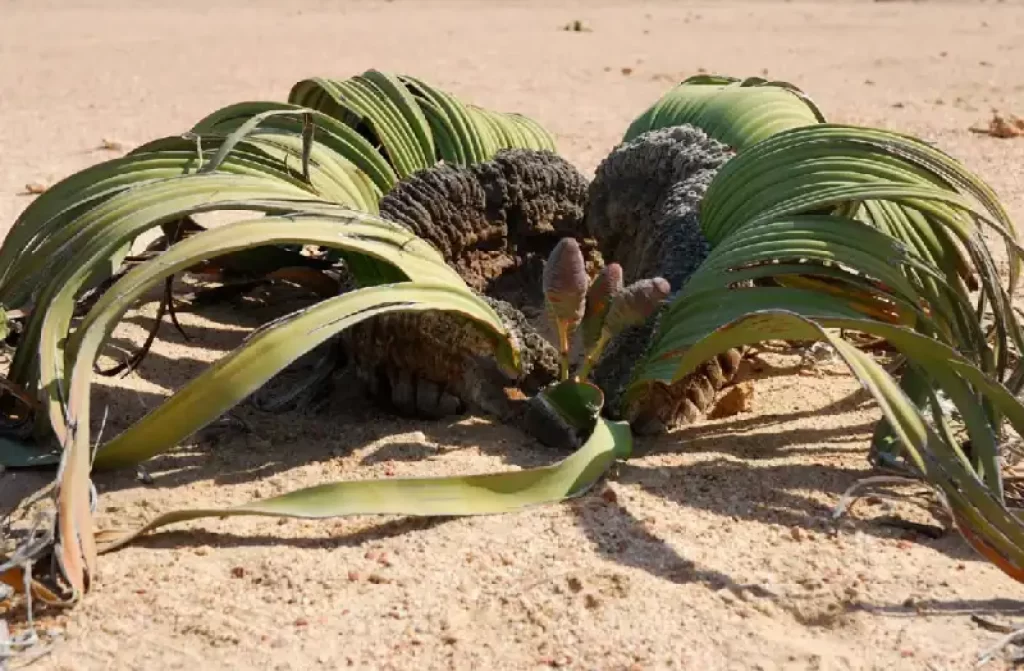
Welwitschia mirabilis is a special kind of plant that lives in the Namib Desert in Africa. It is known for being very different from other plants and has been around for a very long time. Some people call it a “living fossil” because it looks like it hasn’t changed much in millions of years.
What’s interesting about Welwitschia mirabilis is that it only has two long leaves that grow from the base of the plant. These leaves keep growing throughout the plant’s life and can become more than two meters long! Because it lives in a desert where it’s very dry, the plant has clever ways to survive. It can absorb water from the dew that forms on its leaves at night, and it has special parts that help it keep the water it has, so it doesn’t lose too much.
Welwitschia mirabilis is a tough plant that has adapted to its harsh desert environment. It has been able to live for hundreds of years, and scientists are amazed by its ability to survive in such extreme conditions. It is a unique and fascinating plant that shows us how nature can find ways to thrive in even the harshest places on Earth.
How long can Welwitschia mirabilis live?
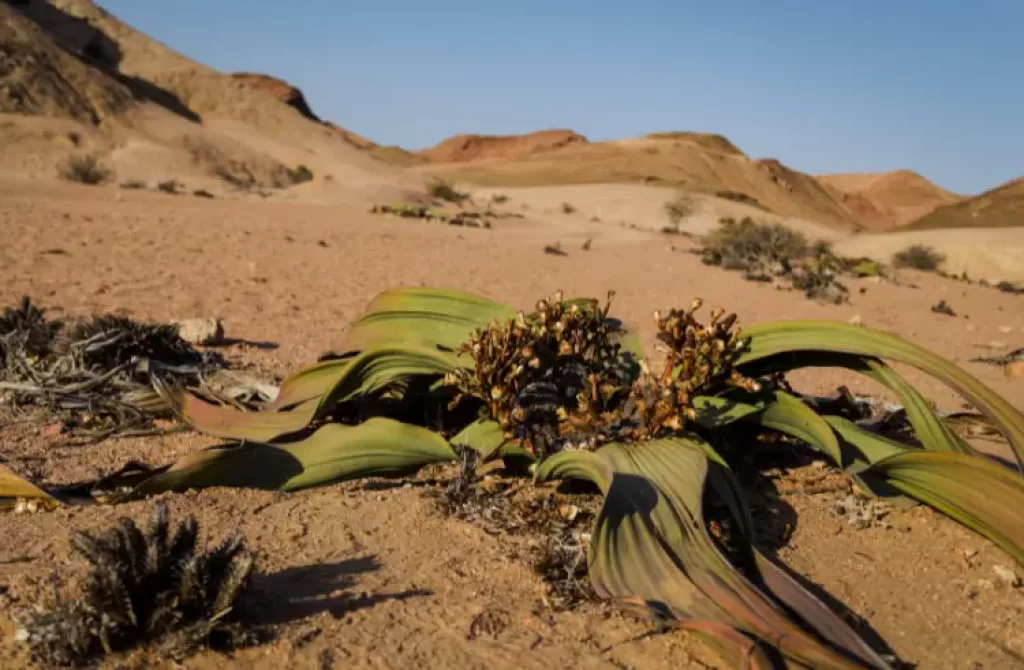
Welwitschia mirabilis has an impressive lifespan, with carbon dating indicating that, on average, they can live for approximately 500-600 years. However, larger specimens have been estimated to be as old as 2000 years.
Their lifespan typically ranges from 400 to 1500 years, making them exceptionally long-lived plants in the botanical world. These remarkable lifespans highlight the resilience and longevity of Welwitschia mirabilis in its unique desert habitat..
Unique characteristics of Welwitschia mirabilis
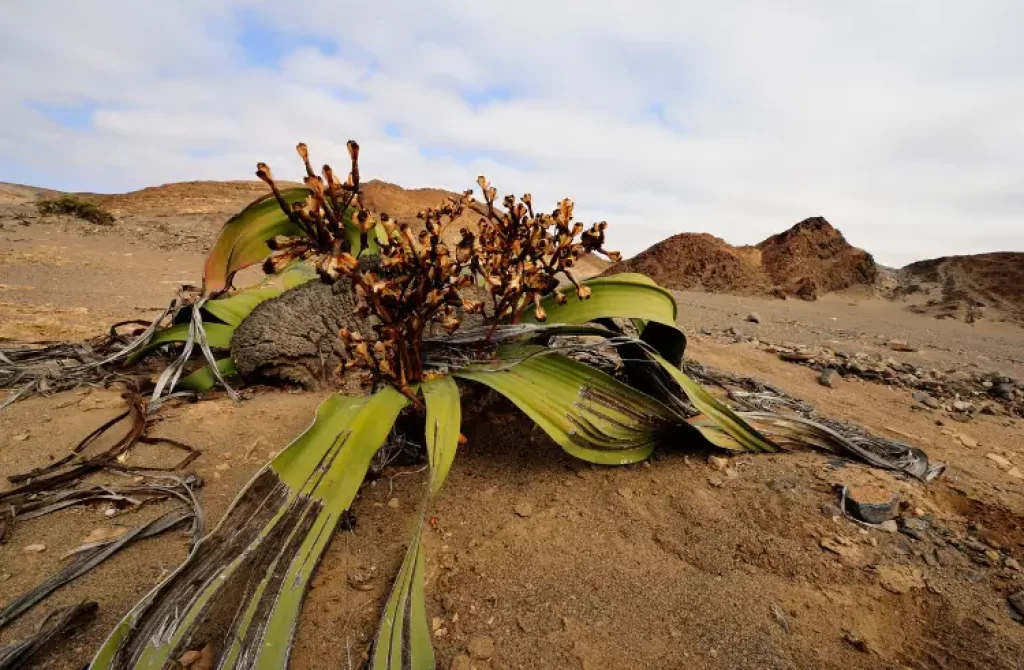
Welwitschia mirabilis possesses several unique characteristics that set it apart from other plants:
Two-Leaf Growth
Welwitschia mirabilis stands out with its unique growth pattern. It features just two elongated strap-like leaves that emerge from its base and persistently grow throughout its life. This distinctive characteristic sets it apart from other plants and contributes to its intriguing appearance.
Desert Adaptation
Welwitschia mirabilis possesses remarkable adaptations that enable it to thrive in the harsh arid conditions of the desert. One of its key adaptations is its ability to absorb water from the dew that forms on its leaves during the cool nights. This unique adaptation allows Welwitschia mirabilis to obtain precious water in an environment where water is scarce.
By capturing and absorbing the moisture from the dew, Welwitschia mirabilis minimizes its reliance on infrequent rainfall or underground water sources.
The specialized structures on its leaves facilitate this process, ensuring efficient water absorption. This adaptation allows the plant to maintain its water balance and survive in the arid desert landscape.
Longevity
Welwitschia mirabilis boasts an extraordinary lifespan, surpassing several centuries. Some specimens have even reached the impressive age of over 1,000 years, earning it the distinction of being one of the longest-living plant species on our planet. This exceptional longevity is a testament to its resilience and endurance in the face of harsh desert conditions.
“Living Fossil”
Due to its primitive appearance and minimal evolutionary changes over millions of years, Welwitschia mirabilis is often referred to as a “living fossil.” It provides valuable insights into the ancient plant world.
Unique Leaf Appearance
Welwitschia mirabilis exhibits a distinctive leaf appearance that sets it apart from other plants. Its leaves are elongated and strap-like, capable of growing to remarkable lengths, sometimes surpassing two meters.
However, due to the harsh desert environment it inhabits, these leaves gradually weather and intertwine, acquiring a tangled and weathered appearance over time. This unique leaf characteristic adds to the plant’s intriguing and rugged aesthetic, reflecting the challenging conditions it endures in the desert.
Endemic to Namib Desert
Welwitschia mirabilis is exclusively found in the Namib Desert, predominantly in Namibia and Angola, making it an endemic species to this specific region. It has evolved specialized adaptations that enable it to thrive in the distinct climate and environmental factors characteristic of the Namib Desert.
This unique habitat specificity contributes to its significance and the conservation efforts aimed at preserving this remarkable plant species.
Conservation Status
Welwitschia mirabilis is considered a vulnerable species and faces the risk of extinction. Its slow growth rate and challenges associated with cultivation outside its natural habitat contribute to its conservation concerns.
These distinctive characteristics make Welwitschia mirabilis a fascinating and remarkable plant, showcasing its ability to survive and thrive in one of the harshest environments on Earth.
How many leaves does Welwitschia mirabilis have?
Welwitschia mirabilis typically possesses only two leaves throughout its lifespan. These long and strap-like leaves emerge from the base of the plant and continue to grow as the plant matures. The two leaves of Welwitschia mirabilis are a distinguishing characteristic of this plant species, giving it a unique and recognizable appearance.
Growth Pattern of Welwitschia mirabilis
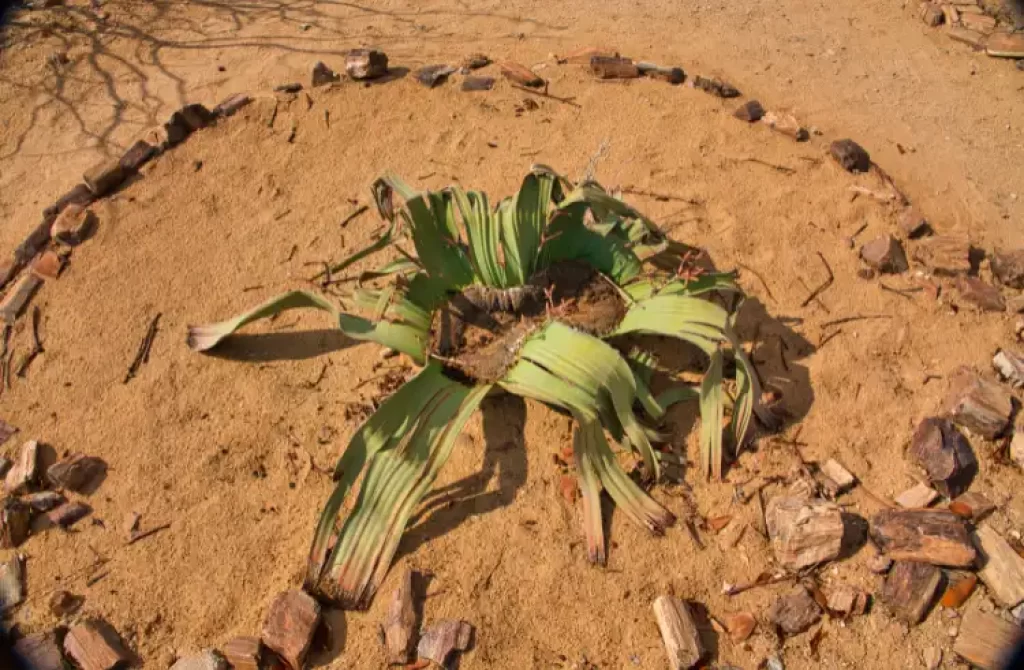
Welwitschia mirabilis exhibits a unique growth pattern that distinguishes it from other plant species. Let’s delve deeper into the stages and characteristics of its growth:
Seed Germination
When a Welwitschia mirabilis seed germinates, it marks the beginning of its life. The seedling emerges from the ground and initiates the growth process.
Emergence of Two Leaves
As the seedling develops, it produces a pair of long, strap-like leaves that emerge from the base of the plant. These leaves are the primary foliage of Welwitschia mirabilis throughout its entire lifespan.
Continuous Leaf Growth
Unlike most plants that have limited leaf growth, Welwitschia mirabilis is exceptional in that its leaves continue to grow throughout its life. These strap-like leaves elongate gradually over time, reaching impressive lengths that can exceed two meters.
Weathering and Tangled Appearance
The leaves of Welwitschia mirabilis undergo weathering and tangling as the plant ages. The harsh desert conditions it inhabits subject the leaves to wind, sand, and aridity, resulting in a rugged and weathered appearance. Over the years, the leaves become intricately tangled, adding to the distinct visual appeal of the plant.
Enduring Growth and Longevity
Despite the challenging conditions, Welwitschia mirabilis perseveres, maintaining its growth and vitality. Its two leaves, which continually extend, contribute to its overall resilience and survival in the arid desert environment.
The growth pattern of Welwitschia mirabilis, characterized by the emergence of two leaves and their continuous elongation, is a remarkable adaptation to its unique habitat.
This growth strategy enables the plant to withstand the harsh desert conditions and thrive over an extended period, contributing to its exceptional longevity and enduring presence in the Namib Desert.
Water Acquisition in the Desert for Welwitschia mirabilis
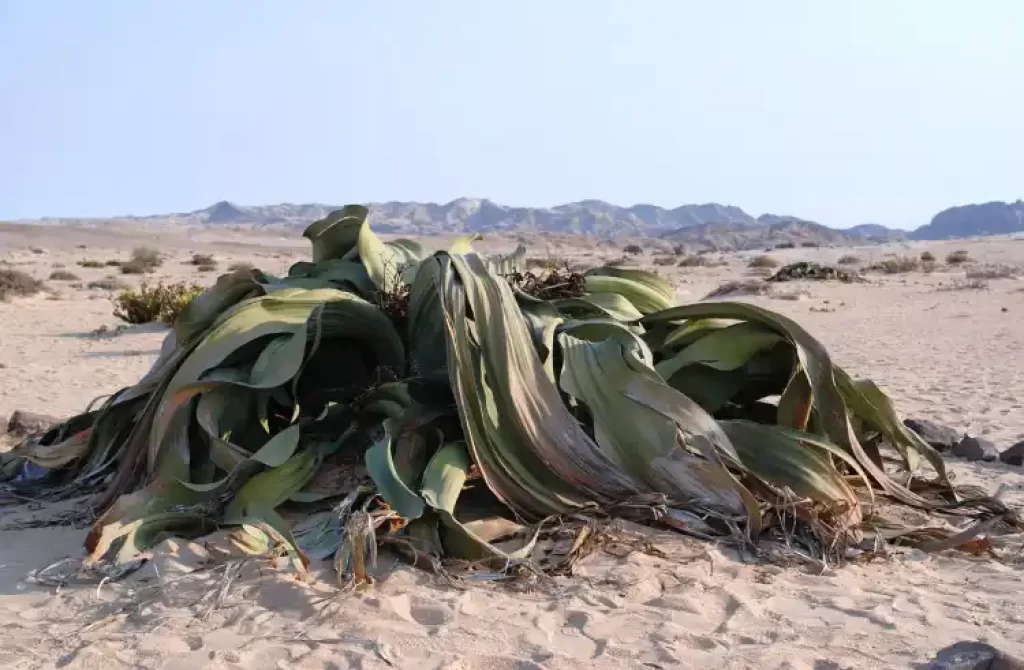
Welwitschia mirabilis, being a desert-dwelling plant, has evolved unique mechanisms to obtain water in the arid environment of the Namib Desert. Let’s explore how this remarkable plant acquires water:
Water Absorption from Dew
One of the fascinating adaptations of Welwitschia mirabilis is its ability to absorb water from the dew that forms on its leaves during the cool desert nights. The specialized surface of its leaves allows it to capture and absorb moisture, replenishing its water supply.
Root System
Welwitschia mirabilis possesses an extensive root system that enables it to explore a large volume of soil in search of water. These roots have the capacity to absorb any available moisture, even from deep within the ground, maximizing the plant’s water uptake.
Efficient Water Conservation
To cope with the scarcity of water in its environment, Welwitschia mirabilis has evolved efficient water conservation strategies. It keeps its stomata, the tiny openings on the leaf surface, tightly closed during the hot and dry daytime hours.
By reducing transpiration, the plant minimizes water loss and preserves the precious moisture it has acquired.
These adaptations collectively allow Welwitschia mirabilis to acquire and conserve water in the desert. Its ability to absorb water from dew, explore the soil for available moisture through its root system, and minimize water loss through closed stomata enable it to survive and thrive in the challenging arid conditions of the Namib Desert.
Why is Welwitschia mirabilis considered a living fossil?
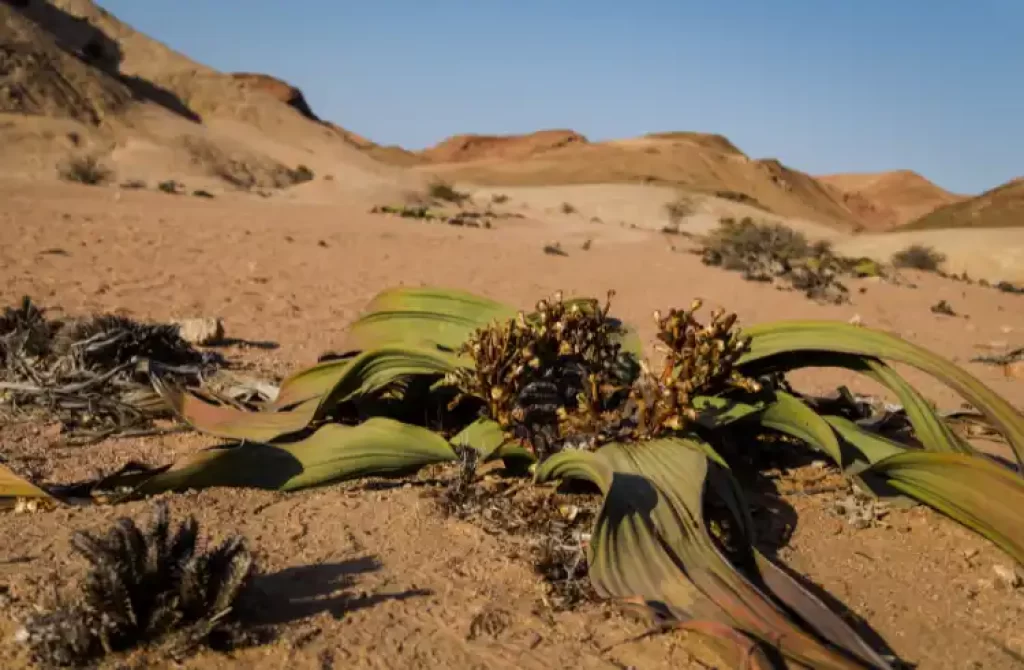
Welwitschia mirabilis is often referred to as a “living fossil” due to its remarkable resemblance to ancient plant species that existed millions of years ago. Here’s why it holds this classification:
Minimal Evolutionary Changes
Welwitschia mirabilis showcases a striking similarity to fossilized plants dating back to the time of dinosaurs. Its physical characteristics, including its unique two-leaf growth pattern and primitive reproductive structures, have remained largely unchanged over millions of years. This lack of significant evolutionary modifications contributes to its status as a living fossil.
Relic from a Bygone Era
The evolutionary lineage of Welwitschia mirabilis can be traced back to a time when plant species with similar traits were more widespread.
However, today, Welwitschia mirabilis stands as a relic, being the only surviving representative of its plant family (Welwitschiaceae). Its existence provides valuable insights into the ancient plant world, earning it the designation of a living fossil.
Window into Plant Evolution
By studying Welwitschia mirabilis, scientists gain a glimpse into the evolutionary processes that shaped plants over millions of years.
Its unique combination of primitive characteristics, such as traits resembling gymnosperms (like pines) and vascular systems akin to angiosperms (like magnolias), offers clues about the evolutionary links and transitions between different plant groups.
Overall, Welwitschia mirabilis is considered a living fossil because its morphology and reproductive features have undergone minimal change over an extended period. Its existence allows us to unravel the mysteries of plant evolution, bridging the gap between ancient and modern plant species.
How does Welwitschia mirabilis adapt to its desert environment?
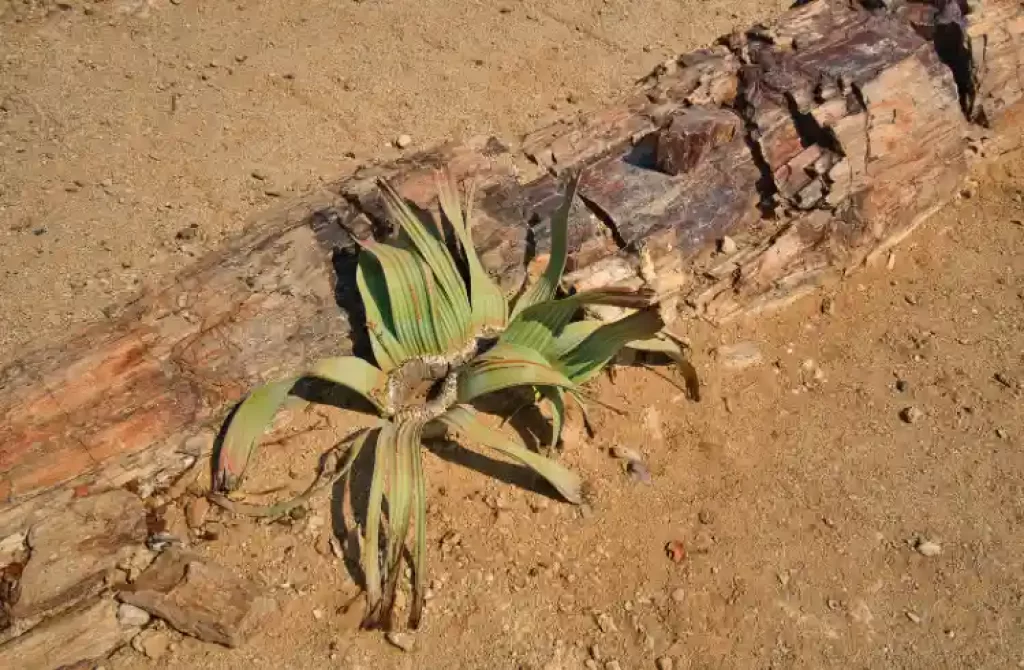
Welwitschia mirabilis has several adaptations that enable it to thrive in the challenging desert environment of the Namib Desert. Let’s explore some of its remarkable adaptations:
Water Absorption
Welwitschia mirabilis has the ability to absorb water from the dew that forms on its leaves during the cool desert nights. Its specialized leaf surface allows for the capture and absorption of moisture, providing a vital water source in the arid environment.
Deep Root System
The plant possesses a robust and extensive root system that delves deep into the ground, enabling it to tap into underground water sources. This adaptation allows Welwitschia mirabilis to access water that is otherwise unavailable to surface-level plants.
Water Conservation
To minimize water loss and cope with the scarcity of water, Welwitschia mirabilis employs effective water conservation strategies. It keeps its stomata (leaf openings) tightly closed during the hot and dry daytime hours, reducing water loss through transpiration.
Reduced Leaf Surface
Welwitschia mirabilis has evolved with long, strap-like leaves that minimize the surface area exposed to the scorching desert sun. This adaptation reduces water loss through evaporation and helps to conserve moisture within the plant.
Slow Growth Rate
The plant exhibits a slow growth rate, which allows it to adapt to the limited resources available in the desert. This slow growth helps in conserving energy and water, ensuring long-term survival in the harsh environment.
These adaptations collectively allow Welwitschia mirabilis to adapt and thrive in its desert habitat. Its ability to absorb water from dew, access underground water sources, conserve water, and sustain a slow growth rate are vital strategies for survival in the arid conditions of the Namib Desert.
How does the appearance of Welwitschia mirabilis change as it ages?
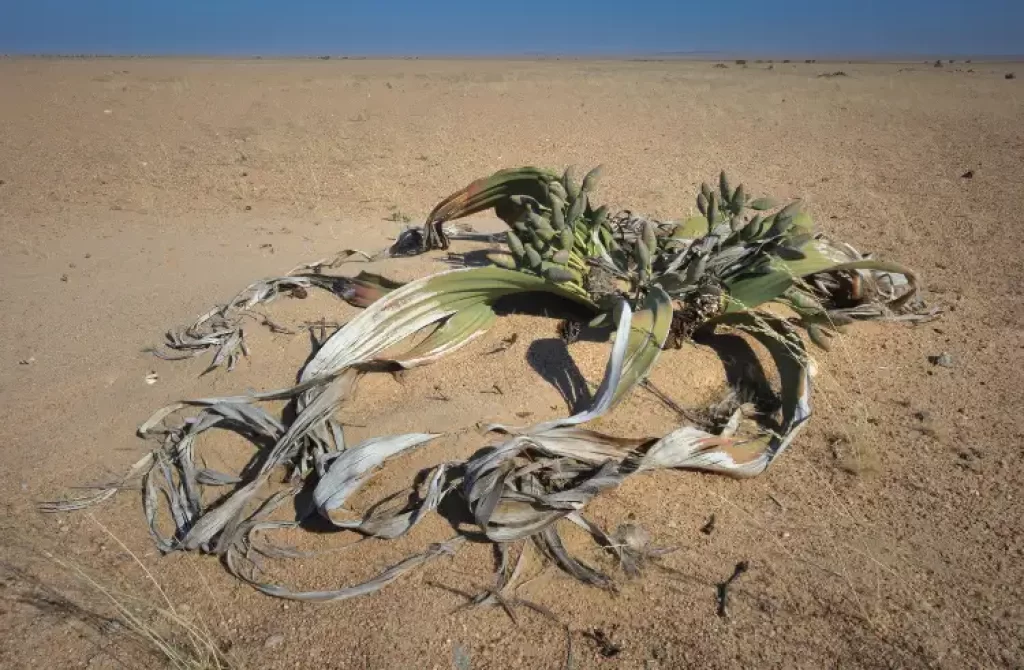
As Welwitschia mirabilis ages, its appearance undergoes distinct transformations. Let’s explore how the plant’s visual characteristics change over time:
Younger Stage
During the initial stages of growth, Welwitschia mirabilis consists of a central stem with a pair of young strap-like leaves emerging from its base. At this stage, the leaves are relatively short and less weathered, exhibiting a greener and more vibrant appearance.
Maturing Stage
As the plant matures, its two leaves continue to elongate gradually. Over time, the leaves develop a more weathered and rugged appearance due to exposure to the harsh desert elements. They may become tattered, torn, or frayed at the edges.
Tangled and Distinctive Look
With the passing years, the long leaves of Welwitschia mirabilis become increasingly tangled and intertwined. The combination of their elongation, weathering, and entangled growth gives the plant a unique, desiccated, and often tangled appearance.
Erosion and Fragmentation
In extremely old specimens, erosion and fragmentation of the leaves may occur, further contributing to the plant’s weathered and fragmented look. The leaves may appear shredded or fringed due to years of exposure to desert winds and sand.
The changing appearance of Welwitschia mirabilis as it ages reflects its resilience in the harsh desert environment. The elongation, weathering, tangling, and fragmentation of its leaves are visible testaments to the plant’s ability to adapt and endure the challenging conditions of the Namib Desert over an extended lifespan.
Welwitschia mirabilis and Its Botanical Relatives
Welwitschia mirabilis, a unique plant species, stands alone in its taxonomic classification. It does not have any close relatives in the botanical world. Here’s why:
Distinct Taxonomic Position
Welwitschia mirabilis belongs to the genus Welwitschia, which is its exclusive taxonomic group. It is the sole representative of this genus, making it a distinctive and isolated plant lineage.
Division and Evolutionary Connections
From a broader perspective, Welwitschia mirabilis falls under the division Gnetophyta, a group of plants that produce seeds. However, within this division, Welwitschia mirabilis occupies a distinct position, displaying unique characteristics that set it apart from other plants in the division.
Unusual Combination of Traits
Welwitschia mirabilis exhibits a combination of traits that make its classification intriguing. While it shares some features with gymnosperms, such as pine trees, its vascular system bears a closer resemblance to angiosperms, like magnolias.
This blend of characteristics creates a botanical anomaly and positions Welwitschia mirabilis as a fascinating “missing link” in plant evolution.
In summary, Welwitschia mirabilis stands as a plant species with no close relatives in its taxonomic classification. Its uniqueness and distinct evolutionary traits contribute to its reputation as a remarkable and solitary species in the plant kingdom.
Gas Exchange in the Unique Environment of Welwitschia mirabilis

Welwitschia mirabilis has evolved specialized mechanisms to carry out gas exchange in its unique desert environment. Let’s explore how this plant ensures efficient gas exchange despite the challenges it faces:
Stomatal Regulation
Welwitschia mirabilis possesses stomata, which are small openings present on the surface of its leaves. However, unlike many other plants, Welwitschia mirabilis keeps its stomata closed during the day to minimize water loss through transpiration. By reducing the opening of stomata, the plant reduces water loss while still allowing some gas exchange to occur.
Night-Time Gas Exchange
To optimize gas exchange, Welwitschia mirabilis primarily carries out this process during the cooler night hours. During the night, when the temperature is lower and humidity is higher, the plant opens its stomata to facilitate the exchange of gases, including the uptake of carbon dioxide for photosynthesis and the release of oxygen.
Crassulacean Acid Metabolism (CAM)
Welwitschia mirabilis employs a unique photosynthetic pathway called CAM. This metabolic adaptation allows the plant to perform photosynthesis efficiently in arid conditions. CAM plants open their stomata at night to take in carbon dioxide, which is then stored as organic acids. During the day, the stomata remain closed, minimizing water loss while the plant continues photosynthesis using the stored carbon dioxide.
Reduced Leaf Surface
Welwitschia mirabilis has long, strap-like leaves with minimal surface area exposed to the harsh desert sun. This adaptation helps reduce water loss through transpiration while still allowing for sufficient gas exchange through the limited surface area available.
These adaptations collectively enable Welwitschia mirabilis to carry out gas exchange while minimizing water loss in its unique desert environment.
By regulating stomatal opening, utilizing night-time gas exchange, employing CAM photosynthesis, and reducing leaf surface area, the plant ensures its survival and efficient use of resources in the challenging conditions of the Namib Desert.
Reproductive Strategy of Welwitschia mirabilis: Adaptations for Desert Survival
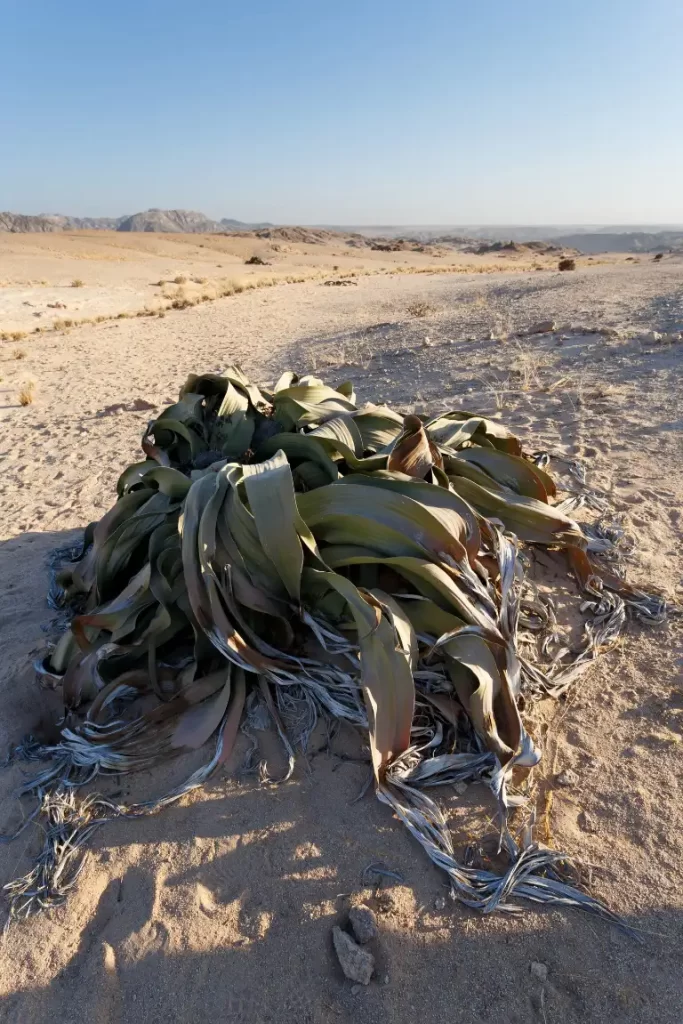
Welwitschia mirabilis exhibits a distinctive reproductive strategy that contributes to its survival in the harsh desert conditions. Let’s delve into the unique aspects of its reproductive process:
Cone-Bearing Plant
Welwitschia mirabilis is a cone-bearing plant, also known as a gymnosperm. It produces separate male and female cones, which contain reproductive structures called reproductive organs.
Sexual Reproduction
Welwitschia mirabilis reproduces sexually, with male and female cones playing crucial roles in the process. The male cones produce pollen, which contains the plant’s male gametes, while the female cones contain ovules, which house the female gametes.
Wind Pollination
The pollination of Welwitschia mirabilis is facilitated by the wind. When the male cones release their pollen grains, the wind carries them to the female cones, where fertilization takes place. The wind plays a vital role in transferring pollen over considerable distances to increase the chances of successful pollination.
Reduced Number of Seeds
Welwitschia mirabilis typically produces a limited number of seeds per cone, usually ranging from a few to several dozen. This conservative reproductive strategy is an adaptation to the scarcity of resources in the desert environment, ensuring that only a select few seeds are produced, increasing their chances of survival.
Long Reproductive Cycle
The reproductive cycle of Welwitschia mirabilis is relatively long, spanning several years. It can take up to two years for the male and female cones to develop, release or receive pollen, and complete the fertilization process.
Seed Dispersal
Once fertilization occurs, Welwitschia mirabilis produces seeds that are dispersed by various means, including wind, water, or animal interaction. This dispersal mechanism allows the species to colonize new areas and expand its range.
The unique reproductive strategy of Welwitschia mirabilis, characterized by wind pollination, reduced seed production, a lengthy reproductive cycle, and diverse seed dispersal methods, contributes to its ability to adapt and survive in the challenging desert conditions it calls home.
Final thoughts
Welwitschia mirabilis stands as a remarkable example of adaptation and resilience in the African desert. Its unique characteristics and survival strategies highlight the incredible diversity of life on our planet. If you’re intrigued by the wonders of nature, I invite you to explore more articles on our website.
Delve into the captivating stories of plants and animals, and unravel the secrets of their extraordinary lives. Let us continue to marvel at the beauty and complexity of the natural world and strive to protect and preserve it for future generations.
You might also like
- All About Common Sunflowers
- Growing Frangipani in Pots
- Cultivating Paphiopedilum Venus Slipper Orchids
- Growing Japanese Maple: Care Tips & Cultivars
References
- Welwitschia. (n.d.). In Wikipedia. Retrieved from https://en.wikipedia.org/wiki/Welwitschia
- de Smet, K., & Joubert, L. (2017). Welwitschia mirabilis: A Review of its Ethnobotany, Phytochemistry, and Pharmacology. Planta Medica, 83(12/13), 981-990. doi: 10.1055/s-0043-116491






